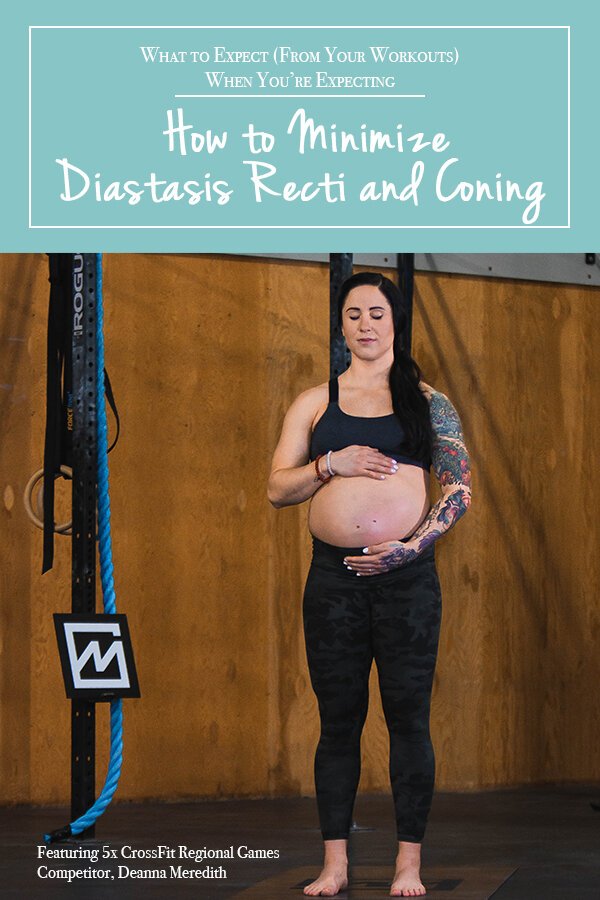What to Expect (From Your Workouts) When You’re Expecting: How to Minimize Diastasis Recti and Coning
Girrrl! Biggest congrats on such an exciting time of your life!
Congrats as well on recognizing the benefits and importance of continuing to workout while pregnant and wanting to get yours (and baby’s) fitness on! Now the question is: where to start? How should you safely modify WODs and your programming? Is there anything you should be mindful of while working out with baby?
Honestly: there’s a TON of information out there about what you “shouldn’t” or “can’t” do. While we appreciate the good intentions behind this (thanks, mom-in-law), we’ve seen that some of the advice out there is inaccurate, old myths, or just plain scary. It’s overwhelming when all you want to do is stay fit and MOVE.
We’ve got your back...or should we say, your “belly“? Ha! Either way: we’ve got you.
Mobility MVMNT has paired up with soon-to-be-mom and 5x CrossFit Regional Games Athlete/CrossFit Vernon Owner and Coach, Deanna Meredith to drop some helpful first-hand pregnancy knowledge bombs in our new Signature Series: Momma Bear Pregnancy Series. In the series, Deanna has combined forces with prenatal care and fitness professionals including doctors; chiropractors; CrossFit gym owners, athletes and coaches; prenatal yoga specialists; and (of course) MVMNT to empower the mom-to-be with accurate information to continue their fitness routine.
To celebrate the launch of the series, we’ll be giving you a three-part sneak peek so you can get a feel for what to expect. This week’s peek: diastasis recti, coning, and things you can do to help minimize strain.
What to Expect: Diastasis Recti and Coning
Diastasis Recti is a partial or complete separation of the rectus abdominis; it is common during pregnancy for this to happen as the uterus expands to make space for the baby. Sounds like something you don’t want, but it is very common and almost guaranteed to happen: about 90% of women who carry to full-term will have some amount of diastasis.
Coning of the belly is a way to spot diastasis. Coning is a literal coning or hollow look of the abdomen as the muscles strain.
There’s no reason to freak out about diastasis; however, it is important to be aware of how you can minimize it.
For a demonstration of coning, check out our video on “What is Coning?” from the Momma Bear Pregnancy Series.
What You Can Do: Diastasis and Coning
Focus on Your Breathing and Adjust Your Intra-Abdominal Pressure (IAP)
Intra Abdominal Pressure (IAP) is the pressure in the abdomen, usually increased intentionally through breathing techniques prior to weightlifting and CrossFit movements.
Traditionally, before challenging movements or heavy lifting, one would brace by pushing air DOWN and OUT into the abdomen, creating a lot of structural integrity and spinal support through IAP.
However, IAP can be increased during pregnancy already, so you don’t want to overdo it. As Dr. Brittany Chase says, “think of it like a tube… if you create too much pressure it has nowhere to go and it will potentially push down on the pelvic floor too much and could damage it.”
So, instead of the traditional bracing, you’ll want to focus on EXHALING the air outward, and lifting your abdomen in and up when pregnant.
Reduce Strain
Limit the amount of separation so you can have a healthy recovery. This means reducing excess strain as it can help protect the stomach and the pelvic floor muscles. Less straining = less diastasis. Every pregnancy is different, and it is up to the individual to decide what modifications are appropriate and when they should be implemented. Keep in mind that during pregnancy your body is experiencing a different type of strain on the abdominal wall than when you are not building a baby! Here are some examples of how and when Deanna modified her workouts to reduce extra strain on her abdomen.
At 18 weeks Deanna stopped situps because she noticed them pulling her abdomen.
After 18 weeks, Deanna stopped kipping movements, because hanging, caused coning.
She was cautious with overhead movements to ensure that they did not cause coning in her belly.
Please keep in mind that these examples are what worked for Deanna, and every woman’s body and pregnancy is unique. We hope to provide a resource to support you in this amazing journey.
Prepare mentally and emotionally
Deanna prepares herself mentally and emotionally before every workout with the following mindset:
“Risk vs. Reward”: ask yourself, “is it worth it?” Just because I CAN do something, doesn’t mean I should. Or, think “this is what is best for me during this time.”
Make a List or a personal contract: make a list of non-negotiable modifications or temporary abstinence from specific movements. To help with this, make a list of movements that present elevated risk and the alternate movements to reduce that risk.
With this information you can participate in your workouts with the movement modification decisions already made! This ultimately supports you in implementing your decisions.
What does my body need today? Your modifications don’t have to mimic the same movement patterns as the exercise. Focus on what your body needs.
A systematic vs. emotional mindset. Keep in mind that this is temporary, these steps are for the long term health of your body and baby. Embrace this journey, try not to dwell on what you cannot do in the gym,, stay true to what your body needs. Remember this is a PR in growing a human!
Want more tips on your CrossFit/Strength & Conditioning Training while pregnant? Join our email list and you’ll be the first to know when the Momma Bear Pregnancy Series launches in early March 2020 PLUS you’ll get exclusive discounts and offers from MVMNT.


